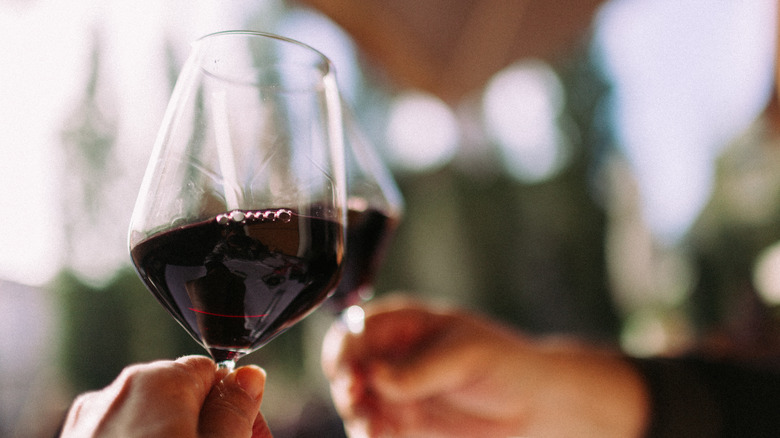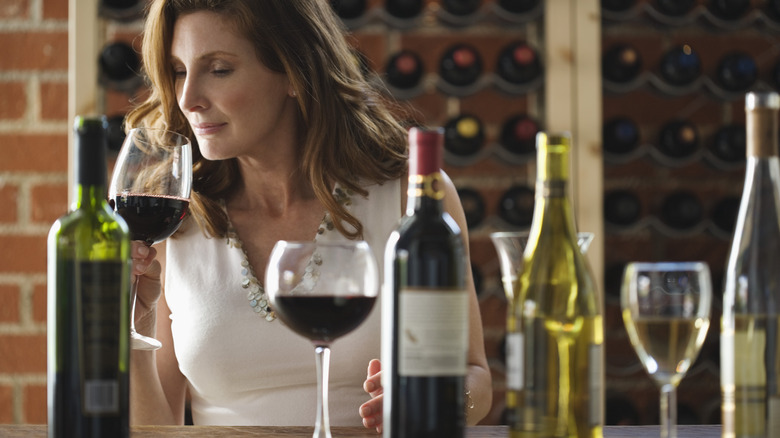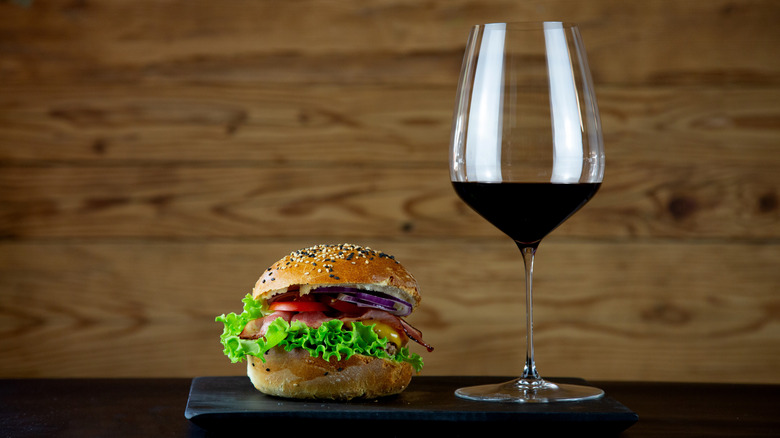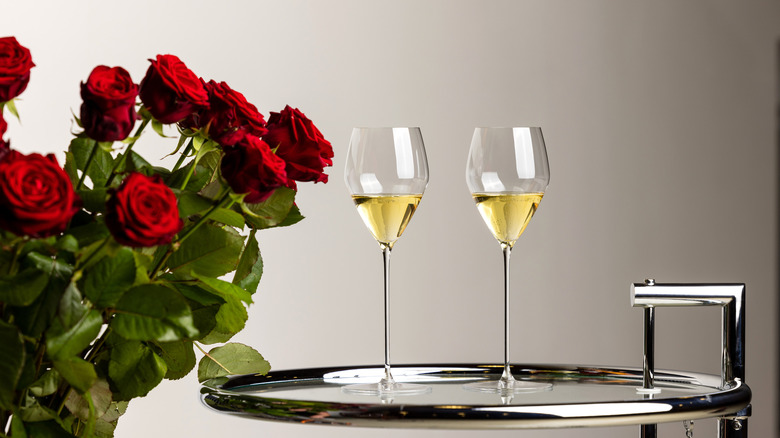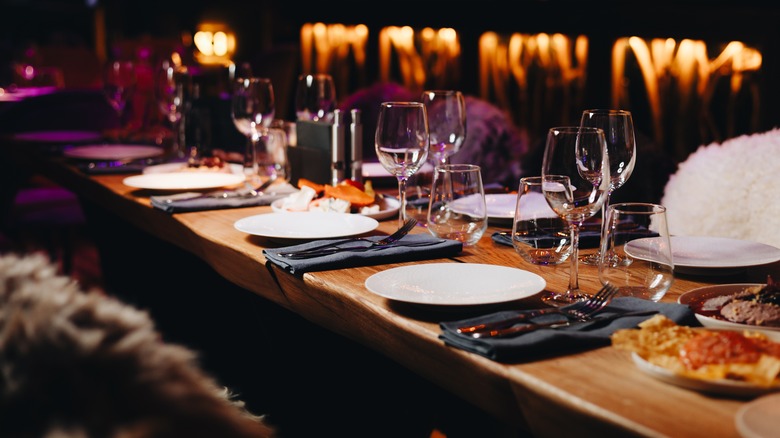The Wine Glass Mistake You Probably Don't Realize You're Making
Sometimes, there's nothing like indulging in a nice bottle of wine at the end of the day. Take a close look at the glass in your hand, though. Sure, it's a wine glass, but it's possible you still made a mistake, and not in the way you're holding it. Believe it or not, certain glasses work best with certain wines. A smaller white wine glass is doing your cabernet a disservice, while sipping a pinot grigio from the large, wide bowl of a cabernet sauvignon glass means missing out on the more delicate characteristics of the wine. Of course, you can drink wine any way you want. But would you automatically grab a beer stein or shot glass to sip that merlot? Unlikely. So why not take another step and use the right wine glass for the job?
"One of the biggest mistakes novice wine drinkers make is drinking wine out of the wrong glassware," said Maximilian Riedel, the CEO and president of Riedel, in an exclusive talk with Chowhound. The company is a premiere manufacturer of glassware, and his family has been working with glass in some fashion since the 1750s and began making specialty designs for specific wine varietals in the 1980s. "The shape of the wine glass can really impact how wine tastes on your palate," he said.
Why there are so many different wine glasses
About 40 years ago, Maximilian Riedel's father Georg began working closely with influential winemakers and critics to study the relationship between bowl size, glass contour, and specific wine varietals, leading to the brand's Vinum collection. Before that, there were larger glasses for red wine and smaller options for white wine, along with a few variations. But no one had spent a lot of time determining why certain glass shapes and sizes seem to work better in certain situations.
There has since been a significant amount of scientific inquiry on the topic. Several studies suggest only minimal or inconclusive differences in the relationship between glass shape and perceptions of taste and aroma. However, a 2015 Japanese study used a "Sniffer-camera" to identify ethanol vapors and monitor wines not only in different wine glass styles but also in martini and highball designs. As reported by Scientific American, the researchers concluded that different "glass geometry" directly influences perceived aromatics (and hence taste, since the two are related) emanating from the same bottle of wine.
Matching the glass and the wine
When learning to pair wines and glasses, start with broad categories. Red wine glasses generally have larger, rounder bowls than white. These allow the tannins found in reds to relax and breathe. It's why you fill a red wine glass to the widest part of the bowl and not all the way up. Conversely, white wine glasses tend to have narrower sides, concentrating the softer aromatics, and their longer stems protect chilled drinks from your warming hands.
From here, glasses get more specific. Those designed for full-bodied Bordeaux-style reds and varietals like cabernet sauvignon or malbec tend to be quite large and round. There's a greater distance between the wine and your nose, which is helpful for drinks with higher alcohol content and complex aromatics. A wider rim also means savoring a fuller sip across your entire palate. Meanwhile, more fruit-driven reds with lower tannins, like Burgundy and other pinot noirs, benefit from tapered sides and a smaller opening to concentrate the aromatics.
White wine glasses boil down to two primary styles: chardonnay and riesling. Both have shorter bowls — bringing these more delicate beverages closer to your nose — and longer stems than red wine glasses. Chardonnay glasses work well with full-bodied, very aromatic whites (viognier is one that works well here). Glasses designed for higher-acid, crisper wines like a dry riesling or sauvignon blanc have a narrower bowl, longer sides, and narrower lip for concentrated sipping. Sometimes they feature a tulip design, with a slightly flared lip (rather than tapered).
Champagne flutes aren't the only option
Champagne and sparkling wines are carbonated, creating distinct demands when it comes to glassware. Most people are familiar with serving these drinks in narrow flutes, but they aren't the only option. The advantage of these glasses comes primarily from the fact you can watch the bubbles rise and dance up the sides of the long glass. But many experts feel flutes are the worst option for Champagne, hampering aromas and flavors that should be allowed to open up.
Instead, consider the coupe. The low, stemmed, open-bowl cocktail glass was a popular Champagne option for several decades before the flute took over. Watch enough 1930s rom-coms and you'll catch characters ringing in the New Year with coupes filled to the brim with Champagne. The wide bowl maximizes aromatics and flavors and is ideal for Champagne towers. Unfortunately, it also maximizes spillage and rapid dissipation of bubbles.
More recently, the trend among aficionados is to sip Champagne from ordinary white wine glasses. The wider bowl allows you to swirl it like a still wine — though don't over-swirl or you'll shake out all the bubbles. Tapered edges and a narrow opening keeps aromatics and bubbles from dissipating too quickly. It's kind of the best of both worlds. Riedel, naturally, created a Champagne-specific glass in its Veloce range. It's designed to function like a white wine glass, but with a distinctive diamond shape which, the company says, creates a "sparkling point" that encourages visually pleasing bubble formation.
Building a varietal–specific wine glass library
The deeper you dive into wine glasses, the more specific types you find. A syrah glass is designed to accommodate the fruity, slightly smoky nature of the grape and its softer tannic structure. It's a bit taller than a traditional cabernet sauvignon glass, with a slightly narrower bowl and a more tapered rim. A merlot glass may look nearly the same as a cabernet glass, but again, it's customized to emphasize the varietal's unique characteristics and maximize the experience.
Though Riedel may have kickstarted the trend for wine-specific glass shapes, other manufacturers, including companies like Zalto, Josephine, and Japan's Kimura, have created their own portfolios. So many specialized options may feel overwhelming, especially at the beginning of your wine journey, but don't worry. Start with a simpler set: Basic red and white glasses. A set can be two, four, eight, or more glasses, depending on how many you regularly use (there is no need to overstock).
As you begin specializing, focus on the wine or wines you drink most, rather than trying to catch them all. "If you are someone who gravitates to a cabernet sauvignon," Maximilian Riedel told Chowhound, "consider investing in owning cabernet sauvignon-specific glassware for the most optimal tasting of your wine at home."
